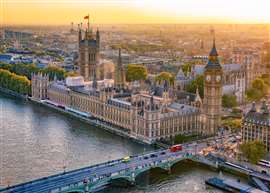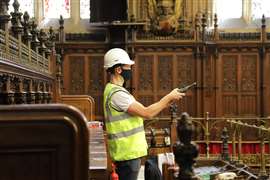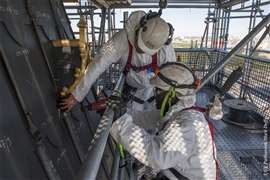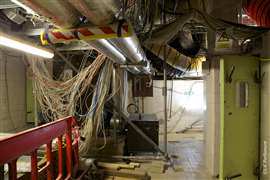Read this article in 中文 Français Deutsch Italiano Português Español
The struggle to agree UK parliament’s £22bn refurbishment plans
15 April 2024
Infested with rats and mice, riddled with asbestos and plagued with leaking pipes, Britain’s historic parliament building is in serious need of renovation. But after five years of debate, and concerns about costs of up to £22bn (US$28bn), politicians appear to have lost the political will to implement ambitious plans for a full refurbishment. Lucy Barnard finds out why.
Members of the UK parliament may be used to being unfairly compared with rodents - but for many working within the walls of the Palace of Westminster, encounters with real life mice are an all-too-frequent occurrence.
“We see them everywhere all the time,” Conservative MP Pauline Latham told the House of Commons. “It’s absolutely disgusting. I have had mice on my computer. I have had them eating things in the office. I had biscuits in a plastic tub, and they chewed through that. It’s absolutely revolting.”
 The Parliamentary Estate. Photo: Adobe Stock
The Parliamentary Estate. Photo: Adobe Stock
And Latham is far from the only one. The UK’s historic parliamentary estate, arguably the most iconic set of buildings in the world, abounds with tales of pest control problems on an epic scale.
According to Sir Charles Walker, chair of the administration committee, responding to a written question from the Liberal Democrats, in the year to January 2024 alone, the UK Parliamentary Estate conducted 348 mouse investigations as well as 61 moth investigations, 107 ‘other’ pest investigations (believed to be mostly pigeons) and installed 33 electric fly killers in the year to January 2024, costing the taxpayer a total of £102,850 (US$131,835).
And pest control is not the only urgent issue which has been facing the decaying fabric of the historic Palace of Westminster. In May 2023, the Commons Public Accounts Committee published a report warning that water and sewerage leaks in the buildings, a constant risk of fire, the danger of falling masonry and the widespread presence of asbestos, known about for many years, meant that Parliament is spending a total of £2m (US$2.6m) a week just on patching up the crumbling estate.
Surveying the palace
For David Goldstone, chief executive of the Houses of Parliament Restoration and Renewal Delivery Authority (R&RDA), a former chief operating officer of the Ministry of Defence and chief executive of the London Legacy Development Corporation responsible for developing the legacy of the 2012 Olympics, it’s an enormous job.
Over the past five years the body has been busy commissioning around 100 surveys looking at ground conditions, heating and ventilation, archaeology, external fabric and stonework and drainage. In 2023 the team also conducted 7,500 hours of intrusive investigations.
Geologists, working alongside archeologists and historians, have drilled 23 boreholes up to 70 meters deep underneath the Palace of Westminster to assess ground conditions: Surveyors have been lifting up floorboards, sensitively drilling into walls and removing ceiling panels to look at a range of issues such as wall cavities, the material makeup of the building and the weightbearing of historic flooring: Specialist teams have also been inspecting hundreds of miles of interconnected power cables, gas, water and heating pipes as well as outdated water and sewerage systems: Acoustics experts have walked 240km around the building, measuring 80 rooms, running 300 individual tests and taking 2,000 measurements.
The building has undergone a thermographic study of heat loss from the building; a survey tree roots and other obstacles under the ground which could impair restoration work; and a study on how to ensure the safety of restoration workers at later stages of the project.
The team also says it is developing an initial Building Information Model of the Palace which is able to generate drawings and plans of any part of the building as well as enable “digital rehearsals” before any real construction work takes place and to which all of the information provided by the surveys undertaken so far is added.
The team has included experts in ecology and doors specialists from Manchester, window surveyors from Glasgow, historic surveyors and specialists from Cambridge, Suffolk and Hampshire
“We’re getting on with the job of protecting the Palace of Westminster, carrying out thousands of hours of surveys to understand the condition of the building,” Goldstone says. “This is a national effort, calling on businesses and experts from across the nation.”
2018 Restoration and Renewal plans
Yet despite Goldstone’s investigations, it seems that the chances of a broader plan for an ambitious refurbishment of the entire parliamentary estate, happening any time soon are swiftly diminishing.
The Restoration and Renewal Delivery Authority was set up in 2018 alongside another quango, the Restoration & Renewal Sponsor Body responsible for making the big decisions about how to undertake the multi-billion pound refurbishment.
 ©Houses of Parliament Restoration & Renewal
©Houses of Parliament Restoration & Renewal
British architecture firm BDP was commissioned to mastermind a suitable temporary alternative. Australian construction company LendLease was appointed to substantially redevelop Richmond House, a 1980s-built former Department of Health office, located to the north of the Palace of Westminster, to create a temporary House of Commons. Separately, the government-owned Queen Elizabeth II Conference Centre, off Parliament Square, would have been internally rebuilt to create a temporary House of Lords chamber.
But in 2020, as the pandemic hit and a cost-of-living crisis engulfed the country, and as the projected costs begam to grow, it soon became clear that many MPs were increasingly concerned that the plan would be unpopular with voters.
At the same time, MPs discovered that restoration work which was being carried out on Parliament’s Elizabeth Tower - the clocktower which houses Parliament’s iconic clock and its ‘Big Ben’ bell - had seen a cost overrun of 176%. Costs for the restoration work on the clocktower, undertaken by a team led by Sir Robert McAlpine’s special projects team starting in 2017, rose from an estimated £29m to around £79.7m, due to decay and damage to hundreds of intricate carvings, asbestos in the belfry, extensive use of lead paint and broken glass in the clock dials.
In 2021, work on the BDP masterplan was officially “paused” and parliament agreed to write off the costs already accrued on designing the plans and the business cases. The Restoration & Renewal Delivery Authority did not respond to emails and phone calls from Construction Briefing requesting further information on the project.
MPs went back to the Sponsor Body and asked it to provide a series of alternative proposals in an attempt to drive down costs and keep track of the timescales. According to its review, the Sponsor Body estimated that cheapest plan involved a full decant of the Palace of Westminster for between 12 and 20 years which meant that works would cost between £7bn (US$8.8bn) and £13bn (US$16.6bn). However, if MPs remained on the estate for much of the time that the works were carried out, restoration would take between 19 and 28 years. And, with a continued presence in the palace, the report estimated that costs could rise to between £11bn (US$14bn) and £22bn (US$28bn) and take between 46 and 76 years.
Coming up with a “new approach”
In January 2022, the commissions, or administrative bodies, for both houses of parliament voted to scrap the Sponsor Body and come up with a “new approach,” with a board of cross-party MPs and peers, clerks and lay members now in charge of devising a shortlist of restoration options.
However, with many politicians’ minds now turning to the expected general election this year, little progress appears to have been made so far.
In October 2023, Lord John Gardiner de Kimble, deputy speaker of the House of Lords said that fully detailed costed proposals would only be presented to MPs in 2025. He said that one option would be for all parliamentary business to move out of the buildings to allow work to take place but with one chamber, probably the Commons returning before full completion.
 ©Houses of Parliament Restoration & Renewal
©Houses of Parliament Restoration & Renewal
“Having costing proposals for both short-listed options will ensure that both houses can make informed, evidence-based and robust decisions about the best way forward for the programme,” he told a House of Lords debate, “recognizing our role as custodians of the historic building to future generations.”
Yet, as politicians continue to procrastinate, others warn that time may be running out for the Palace of Westminster.
Dame Meg Hillier, chair of the committee said that after decades of broad consensus on the critical need to repair and restore the Palace of Westminster, progress had been painfully slow.
“[If] these critical works continue to stall…the real risk [is] that the whole building will be destroyed by a catastrophic incident before the work is done, or perhaps even begun,” she said. “There are already people on decades-long risk watchlists after being exposed to asbestos in the building, a building that’s leaking, dropping masonry and at constant risk of fire.”
|
STAY CONNECTED


Receive the information you need when you need it through our world-leading magazines, newsletters and daily briefings.
CONNECT WITH THE TEAM












